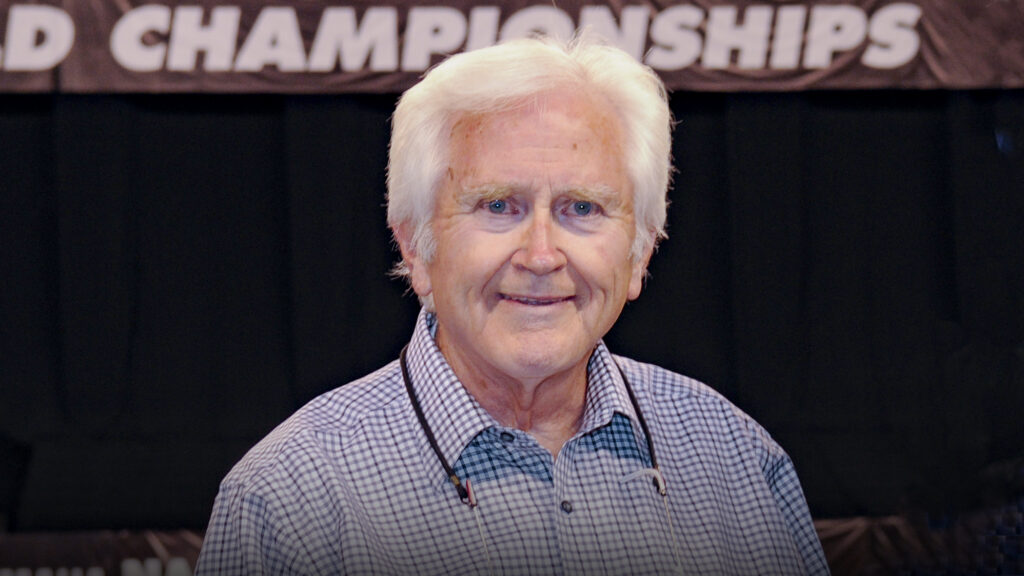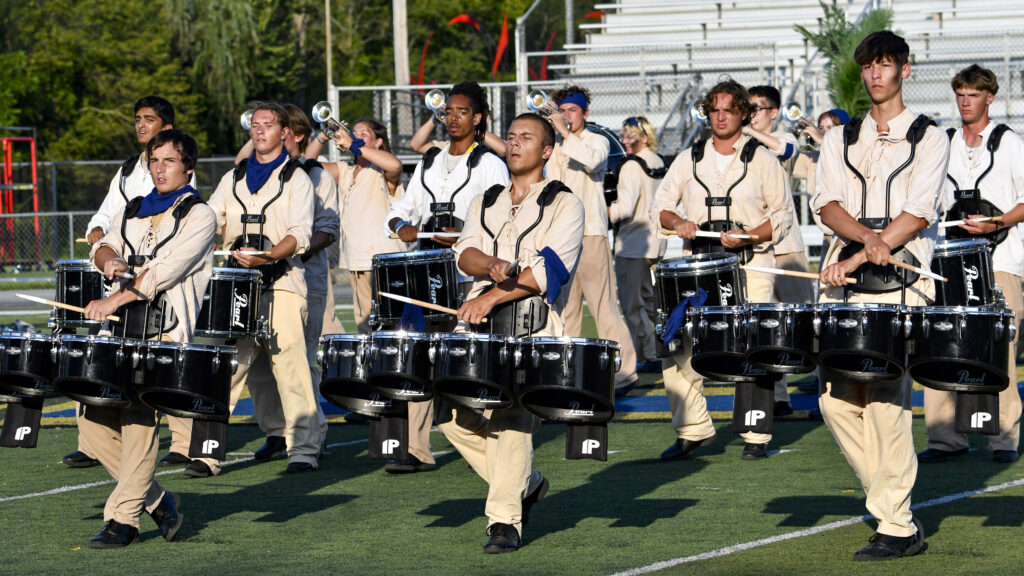This is the first installment of Inside the Arc, a new, twice-monthly column by Chris Hollenback.
Color guard evolves, gains respect and acceptanceBy Chris HollenbackColor guard has come a long way since the 1950s, and has evolved exponentially over the last 15 years. It may not have seemed possible back in the day, but it’s now accepted for guards to dance and spin at the same time, to play characterized roles, and for men to be “manly” while they’re doing it. Consider that just four years ago, color guard didn’t have its own caption and was a bit of a “third-class citizen” to many fans and judges when compared to the horns and drums. Now, armed with their own scoring caption and kids trained in dance before they step off at auditions, legends of drum corps color guard instruction like the Cadets’ April Gilligan and the Blue Devils’ Scott Chandler are putting on shows and getting respect guard people couldn’t dream of back in 1953.
From M&M to split-leaps and unison 7sChandler said the idea of what drill, and choreography within a drill could be came about because of revered choreographer Buzby Berkeley. Guard really began to evolve when Berkeley mixed traditional military marching with the dance choreography from stage and screen. Eventually, color guards started to apply some of the same body movements that Berkeley introduced in Hollywood to their drum corps shows. Guard instructors like Stanley Knaub pushed the envelope by introducing more dance —- a challenge in an activity that favors tradition and has some closed-minded fans who lash out at new ideas.”He brought legit dance to drum corps,” says Chandler. “As much as some people complain about guards dancing, the members that do it, love it. When I was marching (editor’s note: Chandler marched in the Madison Scouts from 1978-81), we were at the beginning of that.”Scouts instructors like Sal Salas and Mike Turner were experimenting with new choreography and weapon work. Chandler would go on to help a winter guard known as State Street Review dominate competition, setting standards along the way. “Dancing makes guard members’ skill on equipment even higher, because they can move their bodies in an enhanced way,” Chandler says. “It has just been a building process.”Winter guard has played a serious part in that process, too, he says.”Theatrical staging was used in winter guard first,” Chandler says. “Now we’re seeing a mix of that in drum corps. We started seeing it in 1983-84. I’m sure somebody was doing it before then, but that’s when theatrical staging could produce massed texture rather than just geometric shapes. It opens up choreography.”The hardest thing about writing work for drum corps guards was adapting choreography to drill forms. It’s still the toughest thing to do, because some members are moving at small step sizes on the inside of the form versus performers on the outside moving at a larger step size. With theatrical staging, you have more flexibility to write guard work and display the mood.”Chandler, who has instructed the Blue Devils guard since 1990, says the corps’ priority has always been to make sure that the horns and drums are in the right place on the field so they can be heard properly. But recently the Blue Devils’ drill writer, Jay Murphy, has explored the motion of musical textures, showcasing the guard by layering the integration and staging in the same way the different sections of the horn line have layered musical parts and drill. Chandler has responded with layered choreography.Around the same time Chandler began working with the Devils, April Gilligan finished her eight-year marching career in the Cadets and began instructing the Cadets guard along with people like Greg Lagola, Michael Cesario and Peggy Twigs.”For the Cadets, it all started to happen in ’89,” Gilligan says. “We started to use characterization to tell the story of “Les Miserables.” Marc Sylvester and I wanted to tell a story. We won color guard for the first time that year.”The Cadets, of course, have been second to none ever since. The New Jersey guard is a perfect example of how far guard has come. “In ’82, we didn’t dance,” Gilligan says. By 1995, Sylvester and Gilligan had them dancing on boxes as if they were doing a Gower Champion routine from 42nd Street. “We wanted to give them a different idiom, allow them to rise above the drum corps and give their stage a different look,” Gilligan says. “To put their equipment down, get up on a box and dance and spin, that’s very difficult to do. It’s also challenging to integrate. I put more effort into making that transition work than cleaning any guard work.”While Gilligan and Chandler go back to classic movies like “On the Town” and musicals like “Cabaret” for inspiration, modern entertainment has continued to push drum corps guards. “MTV has inspired us, and the older works remind us of the basics and how it should be done,” Gilligan says.
High schools drive improvementFamous choreographers aren’t the only ones responsible for better guard shows and increased respect. High school kids have had as much or more to do with it.While guard members used to attend winter drum corps camps once a month and be on their own in between, now most of them are involved in winter guards and many are enrolled in dance classes like the one Gilligan teaches at Braddock High School in Florida. Her guard takes the class very seriously, recently earning a gig at a Miami Heat basketball game. They perform at such a high level that one recent assignment was to watch their favorite sitcom and study how actors perform when they’re in the background. The idea was to teach them the subtle difference between being the primary focus versus filling a supporting role in a show. It doubles as a lesson in modesty and discipline.Chandler sees the difference high school programs have made in the drum corps activity, too.”We’re getting performers who are so well-trained they can leave us and go into the professional world,” he says. “All I have to do as a choreographer is to respond to their talent. The back bend that the Blue Devils guard did in 2001 when they were thumping their hats on their chests reflects their personality, and it just came through in their performance.”Chandler says it’s becoming more acceptable for young people to dance, especially for teen-age men.”The more visible drum corps is, the better,” he says. “The fact that DCI is on TV makes it easier for kids to join a color guard. The fact that there are guys in winter guard definitely is a trickle-down effect from drum corps color guard. The drum corps guys are role models. They’re not effeminate; they’re not wimpy. It takes a lot of strength to do what they do.”Chandler’s high school guard, Logan High School from San Jose, Calif., is a great example. “At Logan, the guys wanted to be in the Blue Devils, so it became OK to learn dance technique. It became cool. We’ve busted open the stereotypes. One of the best ways for a boy to meet a girl, if that’s what he wants to do, is to be in a dance class. They found that out pretty fast.”Now, Chandler has two elementary schools with color guard programs that feed Logan. Parents in the community want their kids to be involved in dance. “The parents know their kids will learn discipline, have a good grade point average and be a part of a team,” Chandler says.
A new respectTen years ago, corps could get away with a weak guard that wasn’t integrated into the show. Today, you can’t make finals without a strong auxiliary.One reason for this is that Drum Corps International began a color guard scoring caption in 2000. The caption has focused on staging and integration. That’s a great first step. Now it’s time to recognize the tremendous choreography and weapon work they’re doing. After all, there’s more to a great guard than just the drill.This will open the door to a future that Chandler and Gilligan think is so bright they have to wear shades.”If our past is any indication of our future, performers will continue to get better and more skilled,” Chandler says. “The Blue Devils were throwing sevens (when the rifle is airborne for seven full revolutions) on rifle last summer. Years ago, I never thought I’d see that outdoors. It’s just going to keep on going.””I can only see drum corps guard getting better because the entire entertainment industry keeps getting better,” Gilligan says.Chris Hollenback marched in the Madison Scouts Drum Line from 1991-97.





